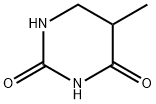Definition
ChEBI: 3-aminoisobutyric acid is a beta-amino-acid that is isobutyric acid in which one of the methyl hydrogens is substituted by an amino group. It has a role as a metabolite. It is functionally related to an isobutyric acid. It is a conjugate acid of a 3-aminoisobutyrate. It is a tautomer of a 3-aminoisobutanoic acid zwitterion.
Purification Methods
RS-β-Aminoisobutyric acid forms colourless prisms by crystallisation from hot H2O which are powdered and dried in vacuo. The purity is checked by paper chromatography (Whatman 1) using ninhydrin spray to visualise the amino acid; RF values in 95% MeOH and n-PrOH/5N HCOOH (8:2) are 0.36 and 0.50 respectively. [Kupiecki & Coon Biochemical Preparations 7 20 1960, Pollack J Am Chem Soc 65 1335 1943.] The R-enantiomer, isolated from iris bulbs or human urine, crystallises from H2O and sublimes in vacuo [Asen et al. J Biol Chem 234 343 1959]. The RS-hydrochloride crystallises from EtOH/Et2O with m 128-129o (also 130o) [B.hme et al. Chem Ber 92 1258, 1260, 1261 1959]. [Beilstein 4 III 1330.]


